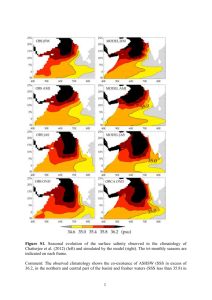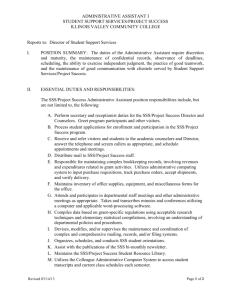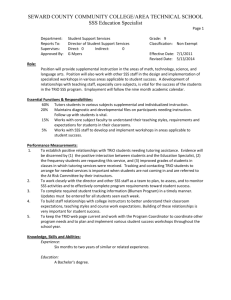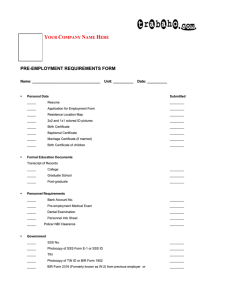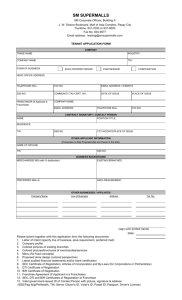External Costs - European Intermodal Association
advertisement
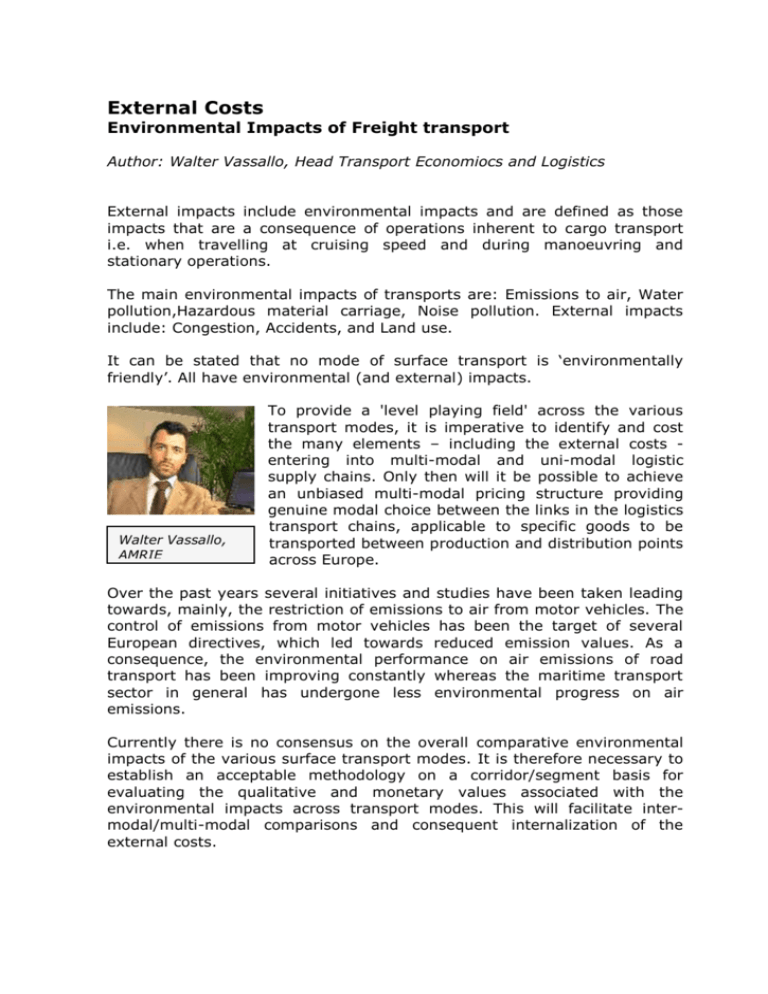
External Costs Environmental Impacts of Freight transport Author: Walter Vassallo, Head Transport Economiocs and Logistics External impacts include environmental impacts and are defined as those impacts that are a consequence of operations inherent to cargo transport i.e. when travelling at cruising speed and during manoeuvring and stationary operations. The main environmental impacts of transports are: Emissions to air, Water pollution,Hazardous material carriage, Noise pollution. External impacts include: Congestion, Accidents, and Land use. It can be stated that no mode of surface transport is ‘environmentally friendly’. All have environmental (and external) impacts. Walter Vassallo, AMRIE To provide a 'level playing field' across the various transport modes, it is imperative to identify and cost the many elements – including the external costs entering into multi-modal and uni-modal logistic supply chains. Only then will it be possible to achieve an unbiased multi-modal pricing structure providing genuine modal choice between the links in the logistics transport chains, applicable to specific goods to be transported between production and distribution points across Europe. Over the past years several initiatives and studies have been taken leading towards, mainly, the restriction of emissions to air from motor vehicles. The control of emissions from motor vehicles has been the target of several European directives, which led towards reduced emission values. As a consequence, the environmental performance on air emissions of road transport has been improving constantly whereas the maritime transport sector in general has undergone less environmental progress on air emissions. Currently there is no consensus on the overall comparative environmental impacts of the various surface transport modes. It is therefore necessary to establish an acceptable methodology on a corridor/segment basis for evaluating the qualitative and monetary values associated with the environmental impacts across transport modes. This will facilitate intermodal/multi-modal comparisons and consequent internalization of the external costs. A recent European Project REALISE (www.realise-sss.org), co-ordinated by AMRIE, developed a robust bottom-up methodology and an accounting framework which performs environmental impact calculations (both in qualitative and monetary terms) for any given origin-destination relationship and for any given transport mode. As categories of external impacts of transport, the tool distinguishes between: local air pollution, global warming, noise pollution, accidents and congestion. The corridor-based approach of REALISE in respect of the Intermodal Comparative Environmental Framework should be accepted as the basis for further EU policy development concerned with improving the environmental performance of the freight carriage transport networks in Europe. Results show that the weak point of Short Sea Shipping (SSS) in terms of environmental costs is related to the emissions to air especially SO 2 (Sulphur Dioxide), NOx (Nitrogen Oxides) and PM (Particulates), which are intrinsically related to the fuel type used and on which the other transport modes promise to improve more rapidly than SSS. Moreover, all three pollutants are rated as the most damaging pollutants of transport to society. To respond to this trend, SSS transport ought to improve its environmental performance as well. Either through improved SSS-specific combustion techniques or altered fuel characteristics. Autonomous technological progress is one way, regulation of used technologies and fuel another one. In addition, targets proclaimed by the proper SSS community regarding Environmental Impacts are a third way to cope with SSS’ relative as well as absolute environmental performance. On the concrete level of corridors all exercises show that under normal circumstances short sea shipping performs better than any other transport mode in all categories of externalities, except for emission of SO2 and S (Sulphur), where road performs better. In the future, however, if one takes into account the assumptions made regarding road transport conformance, at fleet level, with the proposed Euro 5 regulations, the relative position of SSS worsens. In this scenario the road option improves its comparative emission performance more sharply than SSS does. This will lead to a situation in which SSS not only emits more SO 2 and S per 1000 TEUkm, but also more PM, than road transport. The costs of the latter pollutant per emitted gramme is considerable. The results also show that multimodal options involving one or more railway legs, perform less well. This is due to the high noise cost associated with railway transport. The longer the total length of the route that is covered by rail, the higher the aggregated cost of noise inherent to the multimodal option. 2 Two aspects are difficult to analyse satisfactorily at corridor level: air emissions (except CO2 - Carbon Dioxide) and congestion. The impacts of both factors are substantially localized, i.e. concentrated in their impact around urban areas (in the case of SSS specifically around port cities). It would be possible, but not necessarily formally correct, to linearise the totality of the localized impacts along corridors. Formally, the ideal methodology would be to provide a GIS (Geographic Information Systems) mapping of the impacts and have a charging system that reflected the distribution pattern in space and time. This would, however, almost certainly be too complex to establish and administer. The overall main results indicate that - with the exception of certain emissions to air - short sea shipping appears as the transport mode having the lowest overall environmental and external impacts. Providing the air emissions problem is addressed over the next decade this position of short sea shipping may be regarded as assured. Hence, any process of internalizing external costs would see SSS as the preferred mode in cost and price terms. Legend: SSS – Short Sea Shipping GIS- Geographic Information Systems TEU - Twenty-foot Equivalent Unit S - Sulphur SO2 - Sulphur Dioxide NOx - Nitrogen Oxides CO2 - Carbon Dioxide PM - Particulates 3

